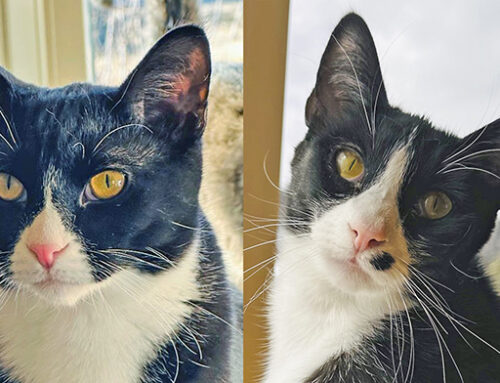Cats are very colorful creatures, inside and out. Thus, it may seem hard to believe, but genetically, there are only 2 colors of cats: black and red with many combinations, dilutions, or mixtures of these.
Unless they have the sex-linked orange gene, in which case, they might be red (commonly called orange or ginger), cats are black. Other genes affect coat colors and patterns, such as the dilute gene (turning a black to gray or orange to cream), point-restricted gene (creating Siamese type marking), pie-bald white spotting gene (creating bi-colored cats like tuxedo) or the W masking gene (which produces a white cat).
Another interesting fact is that all cats have a variation of the “tabby gene” (agouti), which creates the striped pattern. Whether they show their tabby pattern or not depends on whether the cat has the dominant agouti gene or the recessive non-agouti solid color gene. Solid-colored kittens will sometimes show their underlying tabby pattern when young before their adult coat grows in. Also, when an adult cat with a solid coat lies in bright sunlight their underlying tabby pattern can often be seen.
Black cats, black tabbies, and brown tabbies are the most common cat colors. Of the main cat colors, fawn is the rarest, because it relies upon an unusual combination of recessive genes, which are easily masked by other colors.
If you’re a cat person, you know that calico and tortoiseshell cats (those with both black and red coat colors) are almost always female. That’s because the orange gene is carried on the X chromosome. Because males are XY with only one X chromosome, they can only be black or red (or the variations of each).
The same logic explains why orange cats are more likely to be male. Since females have two X’s and males have one X and one Y, this means that a female orange cat must inherit two orange genes (one from each parent). A male only needs one, which he gets from his mother.
So why is this important? There are some who believe that a cat’s color will give a clue to his or her personality. One researcher was interested in the link between how cat color influences adoption rates. After surveying 189 responses, it was found that people were more likely to assign positive personality traits to orange cats and less favorable ones to white and tortoiseshell ones. Orange cats were largely regarded as friendly, white cats as aloof and tortoiseshell cats as intolerant.
The link between cat color and personality has been studied by several research teams, and there is little evidence that coat color determines personality or friendliness. With these prejudices, there are serious repercussions for cat adoption rates if people believe that some colors are friendlier than others. I strongly recommend that people consider every cat as a unique being, regardless of color!
My name is Bolt. I’m 5-month-old lab mix. I used to live on the reservation near Towaoc. I am a happy-go-lucky pup, who loves to be outside. I enjoy playing with my friends, and my Second Chance staff and volunteers are teaching me the basics, such as how to walk on a leash. Like all the pets here at Second Chance, I am ready to show you my true colors, adopt me today.
Second Chance Humane Society’s Animal Resource Center and Thrift Shops have been servicing San Miguel, Ouray & Montrose Counties for 28 years. Call 626-2273 to report a lost pet, learn about adopting a homeless pet, or about our Emergency Response, Community Medical, Spay/Neuter, Volunteer, or other services. View our shelter pets and services online: www.adoptmountainpets.org.







Leave A Comment